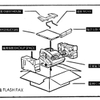For Eng pls scoll down
展览“慢进?我们如何共处”(详情请点击此处)作为一种短暂的现实,试图通过支持长周期的本土工作,从时间维度延展关系并且鼓励各种共处的模式。展览所激发的项目将会像生命有机体一样,在展览之外延续自身的活力。施昀佑受到邀请为展览进行创作,于是他跟另外两位实践者一起发起了《闪电传真机》计划。

施昀佑(与张涵露、朱建林合作),《闪电传真机》,2019-作品由广东时代美术馆2019年展览“慢进?我们如何共处”委任创作,该展览由比利安娜·思瑞克策划
《闪电传真机》是展览的一部分,但是不受展览的空间和时间限制。展览邀请艺术家施昀佑参展,他随着时间周期的开展制定了一项合作计划,整个过程通过展览得以实施,并且会在展期结束后持续运作。第一次工作坊“私密的公共性”已经在美术馆19楼展厅“公开课”教室进行,第二次工作坊“主客之道”将于本周六(1月11日)由张涵露和朱建林主持,从“闪电传真机”出发,走访兰圃及白云山双溪别墅和山庄旅社,并邀请参与者规划一条自己心中的“待客路线”。
《闪电传真机》是一间房子,由施昀佑、朱建林和张涵露创立。他们一起在广州市区租了一个三层的房子,第三层希望与广州的机构以及民间组织取得信赖关系,提供此空间当作共享的客人房,第一层和第二层的空间作为讨论和归档的空间,与使用者共同使用。
闪电传真机,广州市区一栋三层老房子
比利安娜·思瑞克(以下简称BC):《闪电传真机》是你从你对广州日常生活的观察中衍生而来的,这种慷慨的“客人房”在其它城市并非那么常见。可以谈一谈你对这种现象的最初的兴趣吗?它又是怎么展开的呢?
施昀佑(以下简称Ayo):我认为《闪电传真机》的提案是我对客居在广州的经历中很直观的回应:总是在居住空间上被妥善招待,而互动则有适切的界线与考量。因此,我最初是希望通过这次的空间项目来理解所谓地方和外界的关系,并且通过维护这个空间,而去理解人们之间如何在私领域的空间内连结彼此。
BC:你把这个客人房称作一件公共雕塑。在你的想法中,公共雕塑是什么,你怎么去定义它?
Ayo:《闪电传真机》是关于如何去创造一个新的公共空间并且(以私人的方式)连接民众的,以及去回应关于档案的想法。我认为这个词(公共雕塑)是我们认识项目这栋房子的媒介。它包含的意义有服务公众、连接民众以及变得富有创造力。
BC:客人房只在有需要的时候成为私人或公共空间,而且大部分工作都是关起门来做的。你怎么定义当代艺术中这种当下时刻的必要性?
Ayo:我认为艺术在这个过程中不应该只去引起冲突和矛盾。当外部压力太强甚至无法抵挡的时候,我在想艺术是不能可以去探讨一下“保存”或者“安全屋”的概念。于我而言,《闪电传真机》有两层含义:
1) 尝试存留公共空间的实体经验还有人们相处的方式;
2) 保存档案,对抗把档案信息放在社交媒体(比如微信)上的这种观念。
BC:在展览“慢进?我们如何共处”当中,小额筹款促成了作品的产生并且获得了空间。你打算怎么去维持你的计划呢?可以分享一下它背后的经济吗?
Ayo:维系资源确实是运营《闪电传真机》的关键,但是资源有很多种。时间、资金和劳动都很必要。或许这边的问题指的是它背后的“经济”模式,但是我会考虑得更广泛一些。
在定夺筹款从哪里来、用到哪里去之前,我认为“客人是谁”这个问题更加重要。初期有三种方式:
《闪电传真机》会以“消失中的机构”为主题举办辩论。关注劳动权益,性别以及其它无法维系自身运作的社会组织。通过这场工作坊,《闪电传真机》将与本地现存的机构建立关系,并且建立信任共同使用这个空间。这个俱乐部会成为一个不设规划的写作者/研究者驻留地。空间的运营者会邀请三到四个写作者(待定)入住这个空间,时间长度尚未确定下来。展览提供的资金会作为《闪电传真机》最初三到四个月的运营资源,《闪电传真机》的发起人则会为未来三年的运营开支寻求资源。我们很乐意把空间免费开放给来自不同组织的参观者,同时乐意接收捐助,但是目前尚未定下规则。我们认为这个阶段的目标是要通过那些愿意参与进来的主/客人来定义这个空间,并且在这个过程中找到合适的配置资源的机制。

“公开课”区域,2019,广东时代美术馆
“慢进:我们如何共处”展览现场

闪电传真机,广州市区一栋三层老房子
BC:可以谈一下你的研究是怎么引领你做《闪电传真机》的吗?
Ayo:除了对社团历史的讨论,以及对广州待客文化的好奇,还有一件事情是特别引起我兴趣的,就是广州似乎是一线城市中,最多人想移居的地点(但实现的比例并不高),我对他们这种移居的选择感到好奇。综合以上三点,我找了一位来自本地的艺术家朋友朱建林,一位长年宣称要搬来广州但始终未曾行动的策展人张涵露,一起来参与这个工作。我们在过去八个月的时间内反覆讨论,数次共同在城市里进行踏查,最终决定去租一个房子。经过很多次痛苦的讨论和辩论,我们一起制定了“客人房”的规则,希望它能在这个周期里面产生一些有活力的、可持续的东西。
BC:我们刚才聊了很多跟私人和公共空间有关的话题,你提议通过这栋房子以新的角度看待这些边界。你可以在这里说一说用房子提供一些不一样的公共时刻吗?
Ayo:我们最初想清楚了这个问题,那就是《闪电传真机》是一种“储备空间”,因为显而易见地,公众聚集和活动的空间已经被密切监视,对这类型空间的审查限制也越来越多。正如我们所知,很多公共活动都被取消了。虽然客人房在传统意义上是一种私人空间,但是我们很希望大家可以来到这里,相互建立联系但是不引起不想要的关注,让这里成为一个交流和启发的中心。在这层意义上,私家的客人房有时能够成为一道屏障。总的来说,当公共领域在收缩的时候,私人有潜力从它的内部创造一种新的公共。
BC:主与客的概念在这个项目里也很重要,你怎么定义两者呢?
Ayo:在《闪电传真机》里面,只有给客人的空间而没有给当地业主的,因此客人在进入《闪电传真机》的时候就是它的主人了。我们可以在当地志愿者带客人带客人到城里走走的时候看到传统的主客关系,但是其实大多数时间客人兼具了主与客的身份:在空间上,他/她会负责招待从其它当地社区来的访客;在心理上,他/她同时也是那些本地访客的“外来客人”。
一张传真,“慢进”参展艺术家Nicolas Paris在闪电传真机,他也是闪电传真机第一位客人
BC:可以谈一谈房子的名字“闪电传真机”吗?它有什么含义?它的中文有没有另一层含义?
Ayo:我们当时决定把传真机放到房间里,它是一种交流工具和象征。朱建林提到他小时候的一档香港少儿节目。节目每天下午4:30播放,原名叫做《430穿梭机》,到了1989就变成了《闪电传真机》。我们发现节目的歌词对未来和科技充满希望,并且充满了与他人交流的意愿,因此我们决定借用这档电视节目的名称和主题曲作为项目空间的名称。它的中英文含义是一致的。
闪电传真机
循环不息的宇宙 如在照顾着地球
人在天天的进步 无退后
如像霹雳闪电 如是变化百万年
无尽新鲜的发现 造成每天
世界每刻急速旋转 像思想天天的转
散播讯息千百年遥远
无穷新知将你我拉近
无穷传真送到我心
如能将心彼此牵引
这个世界 这个世界 这个世界
更快更真
施昀佑 的作品形式一直与其身处的空间密切相关:他在台北以一栋历史建筑为媒材进行创作,而身处长期的移动状态时,他的作品也进入行李箱,成为档案、文件与书册,讲述着一则又一则的故事。在创作中,他经常使用不同的形式探索纪念碑和记忆的样貌,同时也总是纳入他和国家机器以及机构之间的互动,但相对于一种对抗的姿态,施昀佑更倾向于使用一种共存或渗透的手法来探索这中间的模糊地带。施昀佑的作品曾入选台北美术奖、芝加哥新艺术家协会新艺术家奖。曾受邀参与史勾西根绘画雕塑学校、北极圈艺术家进驻计划、4-18哥伦比亚驻留计划与台北艺术村驻村计划。作品曾于广东时代美术馆,香港Para Site,台北北师美术馆,上海当代美术馆,武汉剩余空间,TCAC,纽约PRACTICE艺术空间等地展出。

The project Modes of Encounter: An Inquiry (click to read more) attempts to extend the temporal frame of the exhibition model, encouraging different modes of encounter by enabling longer term processes on a local level. The exhibition initiated such a context that allowed the different projects to live on, like living organisms, with their own existence beyond the run of the exhibition. Artist Yunyu “Ayo” Shih has been invited to contribute to this exhibition and together with two other practitioners developed the Flash Fax initaitive.The Flash Fax initiative is part of the exhibition but is not bound to the physical and temporal boundaries of the show. The collaborative project was developed by Yunyu “Ayo” Shih and its process is catalyzed by the exhibition but will continue to live well beyond the exhibition’s framework and duration.Flash Fax assumes the form of a house, and was jointly initiated by Yunyu “Ayo” Shih, Zhu Jianlin, and Zhang Hanlu. Together they rented a three-story house in downtown Guangzhou. There, they provide shared guest rooms on the third floors for institutions and civil organizations in Guangzhou. The rooms on first and second floors will serve as discussion spaces and the formation of an archive for common use.Biljiana Ciric: Flash Fax developed out of your observations about everyday life in Guangzhou, and specifically the generosity of the guest room tradition that in many other cities is less common. Can you discuss your initial interest in this phenomenon and how did the idea for this project evolve over time?
Yunyu “Ayo” Shih: The proposal for Flash Fax was a response to my initial experience of being a guest in Guangzhou: a space was always provided to me, a boundary, with careful and detailed interactions. From this, I have tried to understand the relationship between the local and the foreign through this spatial project, and to understand the spirit and behaviors of how people associate with each other through the maintaining of such spaces.BC: The guest room serves also a public sculpture, as you call it. What is the notion of public sculpture that you are employing here? How do you define it?
Ayo: Since Flash Fax is concerned with the creation of a new public space and how to connect people (in a private way), while also responding to the idea of archiving such interactions, I think this term “public sculpture” is a way to understand this project house. This term includes the idea of public service, the intention to connect people, and to be creative.BC: The guest room as a private/public space only becomes truly public when needed, and much of the work around the project is done behind closed doors. How do you understand this necessity within the current moment of contemporary art production?
Ayo: I think the role of art is not only to create conflict and confrontation. When the external, public pressure is too strong, or even irresistible, I turn to the idea of whether art can instead explore ideas of “preservation” or create a kind of “safe house.” In Flash Fax, there are two levels of meaning that I am interested in: 1. To try and preserve the physical experience of the public space and the way people get along with each other within such a space;
2. To save the the physical manifestation of the archive and to fight against the idea of archiving all information on social media (i.e. WeChat).
BC: Through the exhibition Modes of Encounter: An Inquiry a small amount of funding has been provided for this work to take form and a space to be occupied. How do you plan to sustain the initiative and what can you share with us about the economic model to support it?
Ayo: Maintaining a flow of resources is indeed the key to running Flash Fax, but there are many kinds of resources. Time, money, and labor are all crucial ingredients. Therefore, this question you pose about the "economic" model behind the project, I consider it in broader terms.Before determining where the funding will come from and how it will be used, I am more interested in the question: “Who are the guests?” At the outset, there were three approaches to consider:*Workshops related to the collecting and archiving of disappeared institutions: At Flash Fax, there will be a continuous workshop dedicated to “disappearing institutions.” It will focus on labor rights, gender, and other social organizations that were unable to maintain their operations for different reasons. Through these workshops, Flash Fax will establish a relationship with existing local institutions, and gain their trust in order to develop this space together.The moderator of the writers’ club is Zhang Hanlu. It will be a space for unscheduled writers and researchers. The manager of the space will invite three to four (tentatively) writers to stay in the space at some point during the year, the length of time of which can be flexible. Visitors to local art institutions.The funding provided by the exhibition will go to the operations of Flash Fax for the first three to four months, and the initiators of Flash Fax will together work to find additional resources for operating costs for the next three years. We are willing to provide space to visitors from different organizations for free, and we are also willing to accept donations, but the precise rules for the spaces have not yet been determined. We believe the goal at this stage is to find ways to define the space in dialogue with the guests who are willing to participate, and to find suitable channels for resource allocation through this process.BC: How did your your initial research process eventually lead you to develop the proposal for Flash Fax?
Ayo: Aside from my interest in Guangzhou’s long social and community-oriented history, and my own experiences with the city’s unique forms of hospitality—which took place during my several short stays—there’s another phenomenon that made me curious about Guangzhou: I kept meeting people from other big cities, like Beijing and Shanghai, who expressed their willingness to relocate here (though not many of them have actually done so). So, I invited Zhu Jianlin, a local artist and friend, as well as Zhang Hanlu, who expressed great enthusiasm for moving to Guangzhou (yet hadn’t taken any action), to participate in this project with me. I believe their input will help me understand not only the city’s impulses and characteristics, but also the projection or even the imagination of it from the outside. In the past eight months, we’ve talked a lot, exchanged ideas, visited the city’s different corners together, and finally we decided to rent a house. And after many painful discussions and debates, we came up with a set of rules for this “guest house,” hoping it can grow into something vibrant and sustainable on its own terms.BC: We’ve talked a lot about private and public space and through the house you propose to approach these boundaries differently. How might the house you’ve envisioned and created provide different kinds of public moments?
Ayo: We made it very clear at the very beginning that Flash Fax is a sort of “backup space,” because we know that spaces for public gatherings and activities are always being closely monitored and there are more and more censors and restrictions related to this sort of space. As we all know, many public events are often canceled. Though the guest house is a private space in a traditional sense, we do hope can also become a locus of communication and inspiration wherein people come together and build connections to one another without drawing much unwanted attention. In that sense, the private guest house can sometimes be a shield. To sum up, when the public realms are shrinking, private space might be able to create a new public from within.BC: The roles of the host and guest are also very important within this project. How do you determine these two positions? What are the expectations?
Ayo: With Flash Fax, there are only rooms for guests. There is no local host. Therefore the guests become the hosts of Flash Fax when they move into the space. We might observe the traditional guest/host relationship when a local volunteer invites a guest for a walk in the city, but most of the time the guest will simultaneously be the host. Receiving people in the space, they will be in charge of hosting visitors from other local communities. From a local perspective, they will also be visitors as well.BC: Where did the name Flash Fax come from? What does it imply? And does it have a different meaning when translated to Chinese?
Ayo: We decided to place a fax machine as a primary tool of communication and also as a symbol in the room. Zhu Jianlin recalled a children's television show from Hong Kong that he used to watch when he was a kid. The show played at 4:30 pm each day. The original name was “430 Space Shuttle,” but it changed to “Flash Fax” in 1989. We discovered the lyrics to the theme song to be very optimistic, looking to the future and future technologies, and the song's expectations towards the possibilities of communication with others to be very powerful. Thus we decided to borrow this TV show's name/theme song as the name for the project space. In Chinese the name is the same.Lyrics: Hacken Lee
Music: Lam Kwong Pui
The endless cycle of the universe / is taking care of the Earth
People make progress everyday / There is not reverseIt’s like a thunderbolt / It’s been changing for millions of yearsDiscoveries, new and without limits / make up the daysThe world is spinning around / and the mind is spinning aroundDelivering messages hundreds of thousands of years afarInfinite knowledge draws us closerInfinite faxes are sent to my heartIf they could connect the hearts togetherYunyu Ayo Shih’s work has always related closely to the space he situated; In Taipei, a city he lived in for ten years, he turn a whole building into the subject of his art. While he is constantly moving and relocating, his works are stored in suitcases and become archives, documents, and books that tells different stories. He frequently explores different appearances of memorial and memory while at the same time involving interactions between himself and state apparatus. Instead of posing a confrontational gesture, he tends to choose coexistent or penetrated attitudes to explore gray areas. Shih’s work has been exhibited at Para Site, Times Museum, MoNTUE Taipei, Power Station Art Museum in Shanghai, TCAC (Taipei), Practice Space (NY) and many other space. He has been the recipient of the New Artist Society Award (Chicago), Taipei Art Award and has been selected as a participant in the Skowhegan School of Painting and Sculpture, the Arctic Circle Residency, and 4-18 Residency in Colombia.


作者:广东时代美术馆
特别声明:本文为艺术头条自媒体平台“艺术号”作者上传并发布,仅代表该作者观点。艺术头条仅提供信息发布平台。














